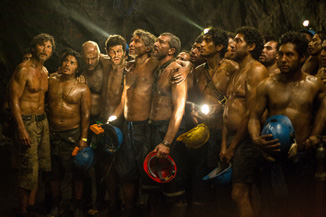|
|
Movie Review: The 33By Ben GruchowNovember 18, 2015
Having a Spanish screenplay and Spanish dialogue, though, would not have begun to fix the problems inherent to The 33. Not the least of this is a colossally messy narrative that wants simultaneously to be a rousing story of confinement and survival, a suspenseful technical procedural, and an indictment of lax bureaucracy and corporate malfeasance, and lacks the stomach or technical aptitude to focus on any one of them for more than the length of a scene or two. It’s pretty surprising, actually, that Riggen and editor Michael Tronick are able to pull a halfway-effective final quarter or so out of the morass, but manage it they did. This can pretty easily be attributed to the inherent magnitude of the incident, rather than any particular cinematic success. The plot follows the broad outlines of reality: 33 miners of varying ages, health, and aptitude for the job are bused from their home city of Copiapó to the San José copper mine, which is identified in the film and in reality as a 120-year-old mine with multiple structural and safety issues. The San Esteban Mining Company is advised of this, in a terse scene in the film’s opening minutes between the shift foreman and the owner of the company. The owner here is obliged to play the role of callous villain, concerned only with profit, and he fulfills the obligation in a way that inspires belief on the part of the viewer who knows about San Esteban’s safety record in reality.
|

|
|
|

|
Thursday, October 31, 2024
© 2024 Box Office Prophets, a division of One Of Us, Inc.


